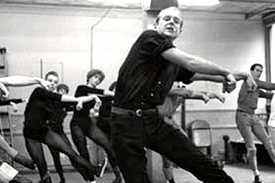 Like many other choreographers before him, Bob Fosse is one who created spectacular work and an entire stylistic repertoire of movement. Fosse died many years ago yet his style is still emulated, taught and performed across the world, especially throughout the US. The revival of Chicago the musical, choreographed by Fosse devotee Ann Reinking, is still running on Broadway, so it is clear Fosse’s work continues to inspire.
Like many other choreographers before him, Bob Fosse is one who created spectacular work and an entire stylistic repertoire of movement. Fosse died many years ago yet his style is still emulated, taught and performed across the world, especially throughout the US. The revival of Chicago the musical, choreographed by Fosse devotee Ann Reinking, is still running on Broadway, so it is clear Fosse’s work continues to inspire.
Fosse didn’t codify a technique in order to train dancers, yet his style serves as an essential base for students of all disciplines; Fosse’s smooth style and attention to detail are invaluable. Fosse is known to have called his dancers “actors,” emphasising that their primary job is to communicate a story as everything he did had an emotional, mental and ethical side to it. The dancers he trained are complete entertainers through their deep understanding of performance. Each step has intent behind it and to convey it the dancer must bring out every aspect of the character.
The Fosse style of jazz encourages dancers to engage emotionally with the movement, and also helps develop to ensemble skills which are essential in any dance discipline. In addition to dancers working together as a group, attention to detail is paramount. The intricate nature of Fosse’s choreography means so much can be conveyed through the subtlety of a single finger wag or a sideways glance. The style requires a strong work ethic because much of the work is based on intricate isolations, so dancers naturally develop a heightened body awareness and focus.
Dancers must be able to watch and replicate movement in a detailed and multi-layered way, and a diligent rehearsal process ensures confidence in performance. While the process of learning the work is intense, it is apparent there are two huge results in both auditions and performing onstage.
